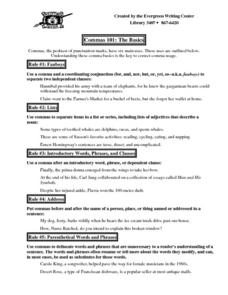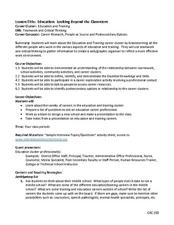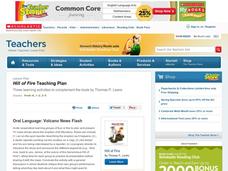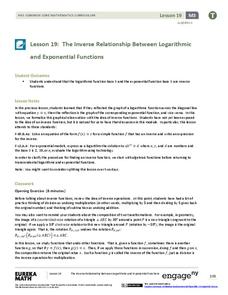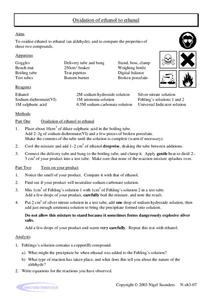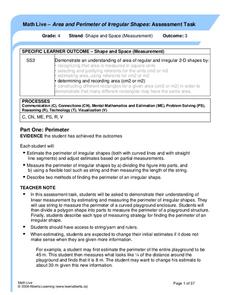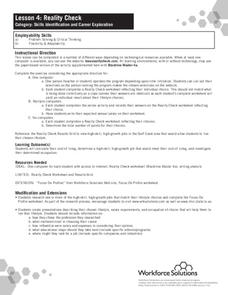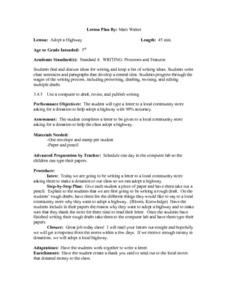Curated OER
Relations and Graphs
Here is a simple, yet clever lesson on how to teach the important concepts of greater than, less than, and equal to. Pupils write their names down on grid paper - one letter per box. They compare their names and find a name that is...
Curated OER
Adding and Subtracting Decimals With Excel
What a great way to have pupils apply classroom learning to real-world skills! They complete problems involving the addition and subtraction of decimals related to banking-type questions, and then use a spreadsheet to display their results.
Curated OER
Commas 101: The Basics
Clear up common questions about commas with this handy resource! Useful as a reference page as well as a grammar activity, it presents six different rules for comma usage, including fanboys, lists, and parenthetical words and phrases. A...
Curated OER
Introduce: Cause and Effect
Introduce beginning readers to cause and effect in a story by exploring it together. Learners make predictions about a book based on its cover, title, and a brief flip through the pages. They listen to an explanation of cause and...
Curated OER
Education: Looking Beyond the Classroom
To better understand what it takes to work in the field of training or educating, learners first explore the education career cluster. After they research the cluster, pupils write questions for a guest speaker. This speaker can be from...
Scholastic
Hill of Fire Teaching Plan
Some books are perfect for drawing connections between multiple subjects. The book Hill of Fire becomes the hub for three very different, yet related activity ideas. First the class hones their oral language skills by creating an...
National Wildlife Federation
Massive Migrations
Turn your students into flocks of migratory birds for this fun lesson on animal migration. Prior to the activity, the teacher creates four different migration routes in the classroom or any available open space, labeling nesting...
EngageNY
The Inverse Relationship Between Logarithmic and Exponential Functions
Introducing inverse functions! The 20th installment of a 35-part lesson plan encourages scholars to learn the definition of inverse functions and how to find them. The lesson plan considers all types of functions, not just exponential...
Columbus City Schools
Asexual and Sexual Reproduction
Can you name a type of reproduction that produces no variation in the offspring? The multimedia lesson covers both sexual and asexual reproduction through videos and discussions. It includes topics such as genetic modification, meiosis,...
California Education Partners
John's Trip Disneyland
It all adds up to one. Pupils solve several items that involve finding sums of fractions in relationship to a whole. The assessment task uses fractions with unlike denominators to determine the amount of a tank of gas and the amount of...
Curated OER
Finding My Pathway
Eighth graders engage in a lesson plan that is concerned with the acquiring of skills necessary to make informed career choices. They examine the type of language that should be acquired for communication in the workplace. They also have...
Creative Chemistry
Oxidation of Ethanol to Ethanal
Here is a laboratory exercise in which chemistry masters conduct an oxidation reaction to change ethanol into ethanal. They compare the original alcohol to the resulting aldehyde by forming a precipitate. This activity is aimed at...
Alberta Learning
Area and Perimeter of Irregular Shapes
Evaluate young mathematicians' understanding of area and perimeter with this series of three assessment tasks. Challenging students to not only calculate the area and perimeter of irregular shapes, but to explain in writing their...
Reed Novel Studies
Summer of the Monkeys: Novel Study
There are more than 260 types of monkeys in the world. With the novel study for Wilson Rawls' Summer of the Monkeys, pupils research interesting facts about the banana-loving primates. They also practice exaggeration, write...
Workforce Solutions
Reality Check
Talk about a reality check! High schoolers complete a lifestyle survey indicating their preference for housing, entertainment, etc., and then calculate the salary required to support those choices. Finally, they research the types of...
Curated OER
What's So Good About Popcorn?
First graders use a thinking map to organize a paragraph. They write and edit their paragraph about popcorn and type the final copy on the computer.
Curated OER
Letter to Self: A Personal Time Capsule
Seventh graders identify the parts of a friendly letter and write a letter to themselves as a part of a time capsule. In this letter writing lesson, 7th graders identify the five parts of a letter and write a friendly letter to...
Curated OER
Adopt a Highway
Third graders write a letter to a community company asking for a donation to their adopt a highway project. In the letter, they include the reasons they want to adopt the highway and thank they store for their time. They word process the...
Curated OER
Typing, Reproducing and Distributing the Job Pamphlet
Students use a word processing program to make a job pamphlet that is suitable for reproduction. This lesson help students write for a purpose. They use the skills of organizing, pre-writing, and revising with a word processing program.
Curated OER
Weather Systems
Fourth graders research weather phenomenon in groups on the Internet and create a slide for the class power point presentation. They include 5 key points (temperature, air pressure, and fronts and descriptions for each type of cloud or...
Curated OER
What will you be for Halloween?
First graders construct a story sticking to the topic with 2-4 sentences.
Curated OER
Ode to the Ordinary
Ninth graders identify an ordinary object and write an ode for the subject. In this poetry writing activity, 9th graders select an ordinary object and define its uses. Students then write an ode for the poem.
Curated OER
Persuasive Paper: RFID
Students write a persuasive essay. In this persuasive writing activity, students argue either for or against RFID technology. Students research RFID both as a class and individually, and follow paragraph-by-paragraph instructions to...
Curated OER
Writing a Criticism
Students view various paintings and write down the adjectives that come to mind. Using the painting, they use information from a previous lesson to write their own critique or point of view. They share their writings with the class.


